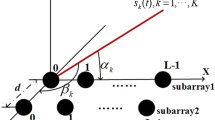Abstract
A novel method is proposed to estimate direction of arrival (DOA) with uniform circular array (UCA) in the presence of phase errors. Inspired by the rank reduction (RARE) theory in the spatial domain, which employs the extra sensors to construct the necessary condition for RARE. i.e., rank reduction vector, a reduction in the radius of UCA is considered for the creation of the rank reduction vector that is only related to the DOA in the UCA mode domain. This indicates that the DOA and the channel phase errors coupling in the steering vector in the spatial domain can be decoupled in the UCA mode domain, and then the optimization function only related to the phase errors is formulated with the rank reduction vector based on the RARE theory employed in the UCA mode domain. Then with the channel phase errors calibrated, the DOA can be estimated via UCA-ESPRIT. The proposed method requires no redundant sensors or calibration sources. Also, it avoids the multi-dimensional iteration, which is superior to the Schur-product based method as it has a larger tolerance for the array aperture. Results verify its effectiveness.


source number and the maximum available radii






Similar content being viewed by others
References
Krim, H., & Viberg, M. (1996). Two decades of array signal processing research: The parametric approach. IEEE Signal Processing Magazine, 13(4), 67–94.
Johnson, D. H., & Dudgeon, D. E. (1993). Array signal processing: Concepts and techniques. Upper Saddle River: Prentice-Hall.
Devaney, A. (2005). Time reversal imaging of obscured targets from multistatic data. IEEE Transactions on Antennas and Propagation, 53(5), 1600–1610.
Ciuonzo, D., Romano, G., & Solimene, R. (2015). Performance analysis of time-reversal MUSIC. IEEE Transactions on Signal Processing, 63(10), 2650–2662.
Roy, R., & Kailath, T. (1989). ESPRIT-estimation of signal parameters via rotational invariance techniques. IEEE Transactions on Signal Processing, 33(7), 984–995.
Capon, J. (1969). High-resolution frequency-wavenumber spectrum analysis. Proceedings of the IEEE, 57, 1408–1418.
Ciuonzo, D. (2017). On time-reversal imaging by statistical testing. IEEE Signal Processing Letters, 24(7), 1024–1028.
Hu, B. (2018). DOA estimation based on compressed sensing with gain-phase uncertainties. IET Radar, Sonar and Navigation, 12(11), 1346–1352.
Meng, D., Wang, X., Huang, M., et al. (2018). Reweighted l1-norm minimisation for high-resolution DOA estimation under unknown mutual coupling. Electronics Letters, 54(23), 1346–1348.
Hu, W., & Wang, Q. (2020). DOA estimation for UCA in the presence of mutual coupling via error model equivalence. IEEE Wireless Communications Letters, 9(1), 121–124.
Ferréol, A., Larzabal, P., & Viberg, M. (2010). Statistical analysis of the MUSIC algorithm in the presence of modeling errors, taking into account the resolution probability. IEEE Transactions on Signal Processing, 58(8), 4156–4166.
Boon, P. N., & Joni, P. L. (2009). A practical simple geometry and gain/phase calibration technique for antenna array processing. IEEE Transactions on Antennas and Propagation., 57(7), 1963–1972.
Zhang, X. (2018). DOA and phase error estimation using one calibrated sensor in ULA. Multidimensional Systems and Signal Processing, 29(2), 523–535.
Weiss, A. J., & Friedlander, B. (1990). Eigenstructure methods for direction finding with sensor gain and phase uncertainties. Circuits, Systems, and Signal Processing, 9(3), 271–300.
Hu, W., & Xu, G. (2019). DOA estimation with double L-shaped array based on Hadamard product and joint diagonalization in the presence of sensor gain-phase errors. Multidimensional Systems and Signal Processing, 30, 465–491.
Hu, W. (2019a). DOA estimation with channel gain-phase uncertainties via Schur-product and RARE algorithm. IET Radar, Sonar and Navigation, 13(8), 1306–1312.
Hu, W. (2019b). DOA estimation for UCA in the presence of gain-phase errors. IEEE Communications Letters, 23(3), 446–449.
Acknowledgements
This work was supported in part by the National Natural Science Foundation of China under Grant 12002172, in part by the Natural Science Foundation of Jiangsu Province under Grant BK20190738, in part by China Postdoctoral Science Foundation under Grant 2020M681680.
Author information
Authors and Affiliations
Contributions
G. Qing did the simulations section, W. Hu did the deduction of the proposed method.
Corresponding author
Ethics declarations
Conflict of Interest
The authors declare that they have no conflict of interest.
Additional information
Publisher's Note
Springer Nature remains neutral with regard to jurisdictional claims in published maps and institutional affiliations.
Rights and permissions
About this article
Cite this article
Qing, G., Hu, W. Channel phase calibration based on RARE in mode domain for direction of arrival estimation. Multidim Syst Sign Process 33, 651–663 (2022). https://doi.org/10.1007/s11045-021-00817-5
Received:
Revised:
Accepted:
Published:
Issue Date:
DOI: https://doi.org/10.1007/s11045-021-00817-5




